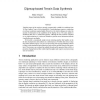Free Online Productivity Tools
i2Speak
i2Symbol
i2OCR
iTex2Img
iWeb2Print
iWeb2Shot
i2Type
iPdf2Split
iPdf2Merge
i2Bopomofo
i2Arabic
i2Style
i2Image
i2PDF
iLatex2Rtf
Sci2ools
SIMVIS
2007
2007
Clipmap-based Terrain Data Synthesis
Satellite images of the earth are currently commercially available in resolutions from 14.25m (Landsat 7) up to 0.61m (QuickBird). Visualizing large terrains or whole planets at these resolutions requires highly efficient level-of-detail techniques to reduce the amount of information to the capabilities of the display device. The same applies to simulations that drive a visualization pipeline: Although the data could be computed at very high resolutions, it is often not desirable to generate more information than the visualization part can display. We describe a conceptually simple terrain rendering pipeline that handles on-thefly data decompression and synthesis in a unified process. Possible data sources range from static satellite imagery over per-texel-processing such as image blending routines to light-weight simulations and synthesizers such as noise and filter based texture generators. These sources are evaluated in multiple threads and the generated data is fed to a geomet...
Computer Animation | Efficient Level-of-detail Techniques | On-thefly Data Decompression | SIMVIS 2007 | Terrain Rendering Pipeline |
| Added | 30 Oct 2010 |
| Updated | 30 Oct 2010 |
| Type | Conference |
| Year | 2007 |
| Where | SIMVIS |
| Authors | Malte Clasen, Hans-Christian Hege |
Comments (0)

